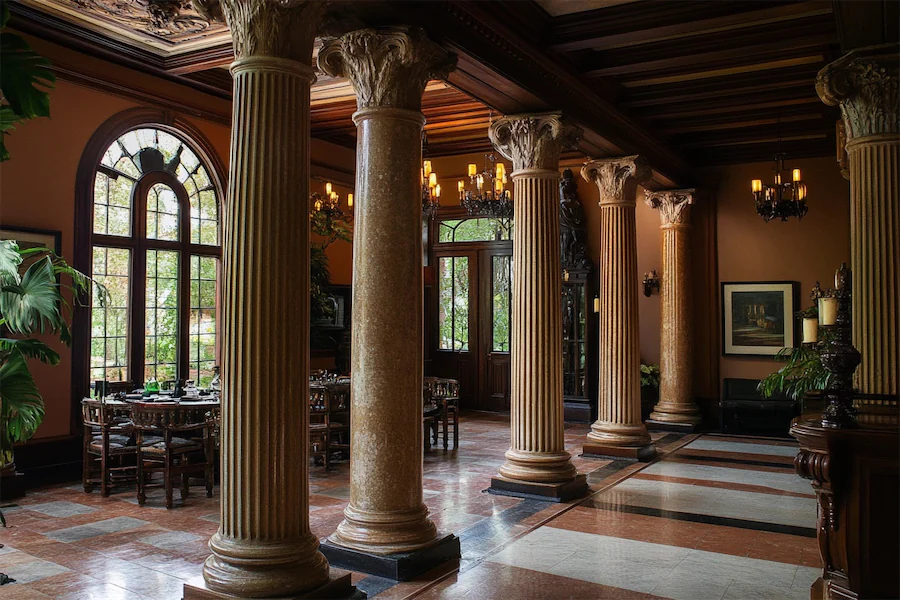Renaissance columns are a hallmark of Renaissance architecture, reflecting a revival of classical Greek and Roman design principles during the 14th to 17th centuries. This architectural movement emphasized symmetry, proportion, and the use of classical elements, marking a departure from the preceding Gothic style.
History and Origins of Renaissance Columns
Originating in Florence, Italy, Renaissance architecture sought to resurrect the aesthetics of ancient Rome. Architects like Filippo Brunelleschi and Leon Battista Alberti studied Roman ruins and Vitruvius’s writings to inform their designs, leading to the reintroduction of classical orders and architectural elements such as columns, pilasters, pediments, entablatures, arches, and domes.
Key Features of Renaissance Columns
Renaissance columns are characterized by the application of the five classical orders:
- Doric: Known for their simplicity and strength, Doric columns have plain capitals and no base. During the Renaissance, architects aimed to use columns and pilasters as an integrated system, often employing Doric columns to convey a sense of solidity.
- Ionic: Recognized by the volutes (spiral scrolls) on their capitals, Ionic columns are more slender and elegant than Doric. They were used to impart a sense of grace and sophistication to structures.
- Corinthian: The most ornate of the orders, Corinthian columns feature capitals adorned with acanthus leaves. Their elaborate design was employed to convey grandeur and beauty.
- Tuscan: A simplified version of the Doric order, Tuscan columns have unadorned capitals and bases, with smooth shafts. They were favored for their understated elegance and were often used in domestic architecture.
- Composite: This order combines elements of the Ionic and Corinthian, featuring volutes and acanthus leaves on the capitals. It was developed during the Renaissance to allow for greater flexibility and creativity in design.
In Renaissance architecture, columns were not merely structural supports but also played a significant aesthetic role. They were often engaged (attached to walls) as pilasters, creating rhythm and harmony in facades. The careful proportioning and spacing of columns reflected the Renaissance pursuit of architectural beauty based on mathematical principles.
Applications of Renaissance Columns
Renaissance columns were integral to various architectural structures:
- Churches: Columns supported arches and domes, contributing to the grandeur of sacred spaces. For instance, Brunelleschi’s design for the Basilica of San Lorenzo in Florence features Corinthian columns that create a harmonious and balanced interior.
- Palaces: In secular architecture, columns were used to articulate facades and courtyards, adding elegance and order. The Palazzo Rucellai in Florence, designed by Alberti, employs pilasters of different orders on each floor, demonstrating the application of classical principles to domestic architecture.
- Public Buildings: Columns conveyed civic pride and stability. The Library of San Marco in Venice, designed by Jacopo Sansovino, features a façade adorned with a sequence of columns and arches, exemplifying the grandeur of Renaissance public architecture.
Considerations When Choosing Renaissance Columns
When incorporating Renaissance columns into architectural designs, consider the following:
- Aesthetic Intent: Select an order that aligns with the desired visual impact, from the simplicity of Tuscan to the ornateness of Corinthian.
- Proportionality: Ensure that the columns are proportioned according to classical principles, maintaining harmony with the overall design.
- Material: Traditional materials like stone and marble were used, but modern interpretations may utilize concrete or composites, affecting the column’s appearance and durability.
Conclusion
Renaissance columns symbolize the era’s dedication to reviving classical antiquity’s architectural splendor. Their thoughtful application in various structures not only provided structural support but also embodied the harmony, proportion, and beauty that define Renaissance architecture.
